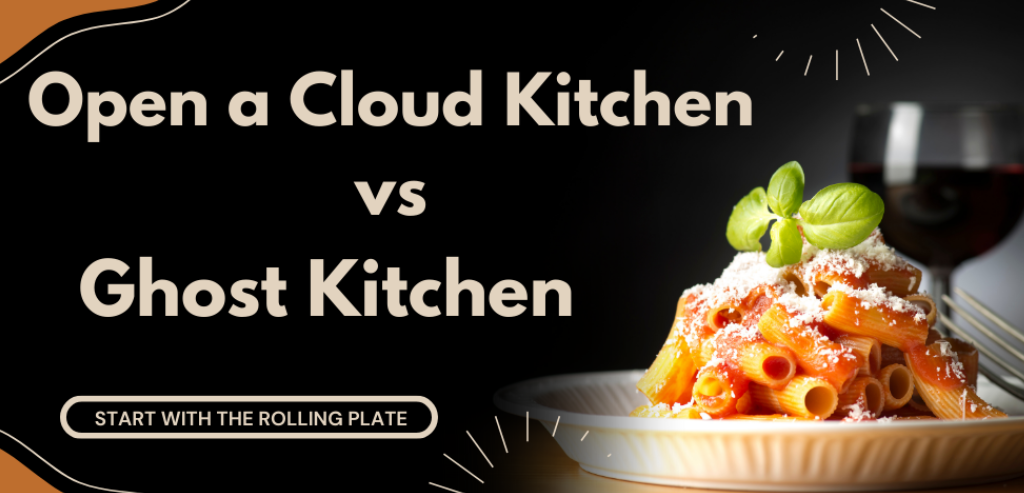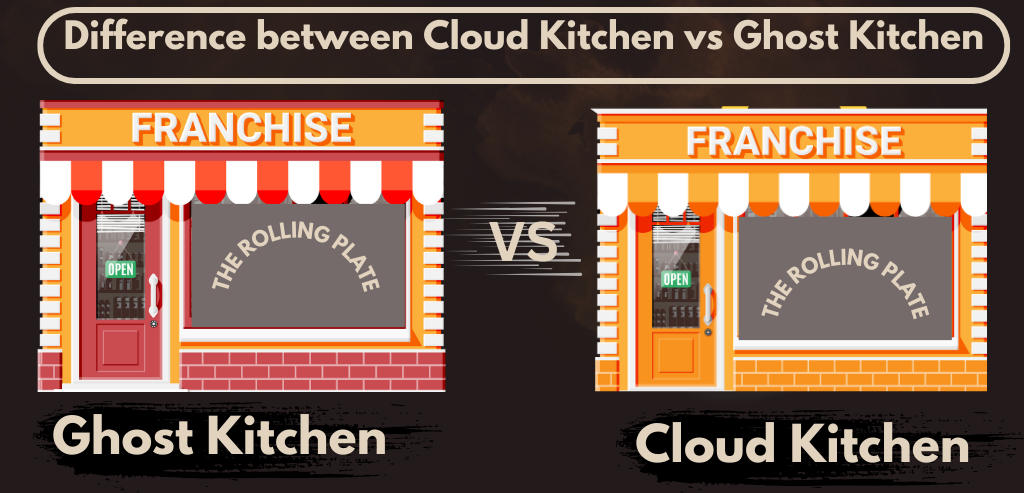Difference between a Cloud Kitchens vs Ghost Kitchens
What is a Ghost kitchen?
A Ghost Kitchen takes the idea of a Cloud Kitchen a step further. It operates exclusively for online orders, with no physical storefront or even a visible kitchen space. The term “ghost” implies that these kitchens are invisible to customers, existing solely in the digital realm.
Low-Cost Franchises with High Profits Cloud Kitchens vs Ghost Kitchens in India
The Ghost Kitchen concept opens up exciting possibilities for entrepreneurs looking for low-cost franchises with high-profit potential in India.
What is a Cloud Kitchen?
A Cloud Kitchen, also known as a virtual kitchen or dark kitchen, is a facility solely dedicated to preparing food for delivery. Unlike traditional restaurants, Cloud Kitchens operate without a physical storefront, focusing on the efficiency of online food delivery services.
This model allows businesses to streamline their operations, minimizing overhead costs associated with maintaining a dine-in space. Cloud Kitchens leverage the power of online platforms to reach a broader customer base and cater to the growing demand for convenient and quick meal options.
Cloud Kitchens vs Ghost Kitchens
Cloud Kitchen Business: A Cloud Kitchens vs Ghost Kitchens operates solely through online platforms, preparing and delivering food without a physical dine-in space. It’s a modern approach that leverages the digital era for a streamlined and cost-effective operation.
Ghost Kitchen and Cloud Kitchen: The terms Cloud Kitchens vs Ghost Kitchens are often used interchangeably. Both involve preparing food for delivery, but cloud Kitchens may also refer to shared kitchen spaces where multiple brands operate. Cloud Kitchens, on the other hand, typically operate under a single brand, focusing on online orders.
Food Business Evolution: The traditional food business model is evolving, and Cloud Kitchens are at the forefront of this change. With the convenience of online ordering and delivery,Cloud Kitchens vs Ghost Kitchenss cater to the changing preferences of modern consumers.
Distinguishing Features: While Ghost Kitchens shares similarities with Cloud Kitchens, the primary distinction lies in their operational structure. virual kiitchen often host multiple brands in a shared space, promoting collaboration and cost-sharing among businesses.
Successful Business in the Food Industry: Both Cloud Kitchens vs Ghost Kitchens offer advantages for entrepreneurs entering the food industry. The digital-first approach, lower overhead costs, and adaptability to changing consumer behaviors make them viable and successful business models in today’s dynamic market.
FOCO and FOPO Models in Cloud Kitchen Business:
- FOCO Model: Franchise Owned, Company Operated
- In the FOCO model, individuals own the franchise, while the company actively manages the operations. This ensures consistency, quality, and the company’s direct involvement in every aspect of the Cloud Kitchen business.
- FOPO Model: Franchise Owned, Franchise Operated
- In the FOPO model, individuals own and operate the franchise independently. While this provides more autonomy, it may require a higher level of personal involvement in day-to-day operations.
Ghost Kitchen Concept:
The Cloud Kitchens vs Ghost Kitchens Concept, which takes the idea of a Cloud Kitchen to the next level. A food business is like an invisible kitchen – it operates solely for online orders without a visible storefront or kitchen space. The term “ghost” signifies its virtual nature, existing primarily in the digital realm.
Key Differences:
- Visibility:
- Cloud Kitchen: Has a digital presence and may or may not have a physical storefront.
- Ghost Kitchen: Operates exclusively online without a visible kitchen or storefront.
- Online Operation:
- Cloud Kitchen: Primarily serves customers through online platforms but may also have a physical location.
- Ghost Kitchen: Operates solely through online channels, embracing a fully virtual approach.
- Low-Cost Franchises with High Profits in India:
- Cloud Kitchen: Offers a budget-friendly approach for entrepreneurs looking to enter the food industry. It minimizes overhead costs associated with maintaining a physical space.
- Ghost Kitchen: Takes the low-cost advantage even further by eliminating the need for a visible kitchen, allowing entrepreneurs to focus on quality ingredients and efficient operations.
Choosing Between Cloud Kitchens vs Ghost Kitchens:
- Business Model:
- Cloud Kitchen: Offers a mix of digital and potentially physical presence.
- Ghost Kitchen: Thrives solely in the online space.
- Cost Considerations:
- Cloud Kitchen: Presents a cost-effective option compared to traditional restaurants, with potential savings on rent and maintenance.
- Ghost Kitchen: Takes cost-effectiveness to the next level by eliminating visible storefronts and associated expenses.
- Wider Reach:
- Cloud Kitchen: Can tap into a broader audience through both online and potentially offline channels.
- Ghost Kitchen: Capitalizes on the expansive reach provided by online platforms, catering to a larger customer base.
How to Open a Cloud Kitchen vs Ghost Kitchens?

a. Market Research: Begin by conducting thorough market research to identify the demand for specific cuisines in your target location. Understanding the preferences of your potential customers is crucial for a successful Cloud Kitchen.
b. Location Selection: Cloud Kitchen doesn’t require a traditional storefront, choosing the right location is still essential. Opt for an area with a high demand for online food delivery services and consider proximity to key delivery zones.
c. Licensing and Permits: Ensure you comply with all local regulations and obtain the necessary licenses and permits for operating a Cloud Kitchen. This may include food handling permits and health department approvals.
d. Online Presence: Establish a robust online presence through food delivery platforms and your own website. Invest in professional food photography and create a compelling menu to attract customers.
e. Technology Integration: Leverage technology to streamline operations. Implement efficient order management systems and delivery tracking solutions to enhance the overall customer experience.
Choosing Between Cloud Kitchen and Ghost Kitchen:
When considering food franchises in India, the choice between Cloud and Ghost Kitchens depends on various factors.
- Business Model:
- Cloud Kitchen: Offers a mix of digital and potentially physical presence.
- Ghost Kitchen: Thrives solely in the online space.
- Cost Considerations:
- Cloud Kitchen: Presents a cost-effective option compared to traditional restaurants, with potential savings on rent and maintenance.
- Ghost Kitchen: Takes cost-effectiveness to the next level by eliminating visible storefronts and associated expenses.
- Wider Reach:
- Cloud Kitchen: Can tap into a broader audience through both online and potentially offline channels.
- Ghost Kitchen: Capitalizes on the expansive reach provided by online platforms, catering to a larger customer base.
Get Started with The Rolling Plate: Your Cloud Kitchen
Food Franchise Expertise: The Rolling Plate stands tall as a seasoned player in the food franchise arena. With expertise in the Cloud Kitchen business, it offers entrepreneurs a golden opportunity to venture into the culinary world.
No Rental, No Salary, High Margins: The unique proposition of The Rolling Plate lies in its no rental, no salary, high margins approach. Entrepreneurs can join hands with confidence, knowing that operational costs are minimized, maximizing profit potential.
Best Franchise Business in India: The best cloud kitchen franchise business in India, The Rolling Plate brings a trusted brand to the table. Franchisees benefit from the established reputation, ensuring a head start in the competitive food industry.
Franchise Business Ideas: The Rolling Plate doesn’t just offer a cloud kitchen business; it presents a canvas for franchise business ideas to flourish. Entrepreneurs can explore diverse concepts under the guidance of a reliable and experienced partner.

